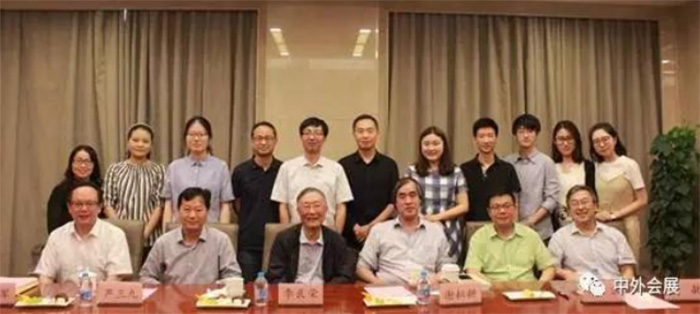
On June 17, School of journalism and Communications atShanghai University and Shanghai MICEE Institute successfully held the 2017 doctoral dissertation defenses in exhibition studies at the Haina Hall of the Lehu Building at Shanghai University's Baoshan campus. To ensure the rigor of emerging interdisciplinary development and the academic authority of dissertation defenses, Shanghai MICEE Institute specially invited a defense committee consisting of five academic experts: Professor Li Liangrong from Fudan University, Professor Yan Sanjiu from East China Normal University, Professor Xie Yunge from Shanghai Jiao Tong University, Professor Yang Haijun from East China Normal University, and Professor Zheng Han from Shanghai University, to conduct on-site oral defenses of the doctoral dissertations of Ren Zhongfeng and Wei Dianlin.
The dissertation defenses were held in two sessions, presided over by defense committee chairman Professor Li Liangrong. The defense agenda included supervisor Professor Zhang Min's reports submitting the doctoral students' degree coursework and research results for review, dissertation statements by the candidates, questioning by the defense teachers, answering by the candidates, open reviews by the defense teachers, closed-door discussions by the defense committee, and result announcements by the defense committee chairman.
In the first session, Ren Zhongfeng's doctoral dissertation was titled "Communication Mechanisms of the Meeting Alliances During the Spring and Autumn Period". It viewed the meeting alliances among princes during the Spring and Autumn period as a communication phenomenon, and discussed the inherent communication mechanisms of the alliances from the perspective of international communication. The dissertation systematically combed, refined and explored the needs, advantages, decision-making and persuasion, rituals, agenda, treaty texts and other six aspects of alliance communication around the question "Why did alliance activities become the most important communication platform among Spring and Autumn states?". It also put forward original thinking by integrating relevant theories. The experts unanimously spoke highly of the topic selection and discussions, believing that it provided new perspectives in interpreting alliance activities during the Spring and Autumn period and expanded the field of communication studies through in-depth explorations of alliance mechanisms. The experts also questioned the use specifications of some theoretical concepts in the dissertation, and suggested further explorations in the context of Spring and Autumn ritual culture and the emperor's authority, closely combining historical contexts to examine specific issues, such as adding quotation marks for the "international relations" concept and making strict definitions.
The second doctoral dissertation defense was by Wei Dianlin, with the dissertation titled "Discourse and Hegemony: Exhibition Communication Strategies in the Rise of the United States". Taking major international exhibition activities hosted or participated by the US in the early 20th century as the research object, it placed them in the historical context of the rise of great powers, and deeply explored the role of exhibitions in the reorganization of international relations and shifts in global power. The experts believed the dissertation had broad vision and historical insights, possessing certain strategic heights. However, the slightly grand historical narrative still needed improvement in precisely positioning perspectives and handling specific details. Further combs and demonstrations of the characteristics of US discourse in exhibition communication across different periods and its discourse evolution trajectory were also needed.
The defense strictly upheld procedures and standards. It fully affirmed the value of topic choices, angles, academic norms and academic attitudes of the two candidates, while raising many sharp and profound questions on details like interpretations of core concepts and directions for deepening the dissertation. The wonderful critiques from the experts also provided an "on-site teaching course" for the other postgraduate students present to learn from. After serious discussion and anonymous voting, the defense committee agreed that the doctoral dissertations of Ren Zhongfeng and Wei Dianlin passed the oral defense successfully and recommended doctoral degree conferment. Under the attentive cultivation and long-term guidance of their supervisor, the perseverance and dedication to academic contributions demonstrated by the two doctoral students in the face of heavy workloads, their rigorous and earnest academic attitude, and pursuit of excellence deserved learning. Their success was hard-won fruit after enduring hardships!
For participants at this doctoral dissertation defense, the defense itself still carried a certain sense of solemnity. After all, this was only the third defense for the emerging interdisciplinary field of exhibition studies, which remains a fledgling endeavor. Its significance lies not only in training talents and boosting morale for the exhibition industry, but also in establishing credibility and standards for exhibition studies.
It is understood that Shanghai University's postgraduate training adopts strict procedures to ensure the quality of doctoral and master's talents. In the middle stage, apart from entrance exams and interviews, degree coursework, research output reviews, the graduate school requires three stages and three reviews for doctoral dissertation submissions alone: project initiation report, mid-term review, and pre-defense, municipal blind review, university blind review, and peer review. As pioneers of an emerging interdisciplinary field, the exhibition studies direction under the School of Communication Studies faced even more difficulties and challenges unseen in other disciplines. However, in the face of building China into an exhibition powerhouse and increasingly fierce international competition, as well as fair, just and open talent cultivation policies, this is all understandable.


